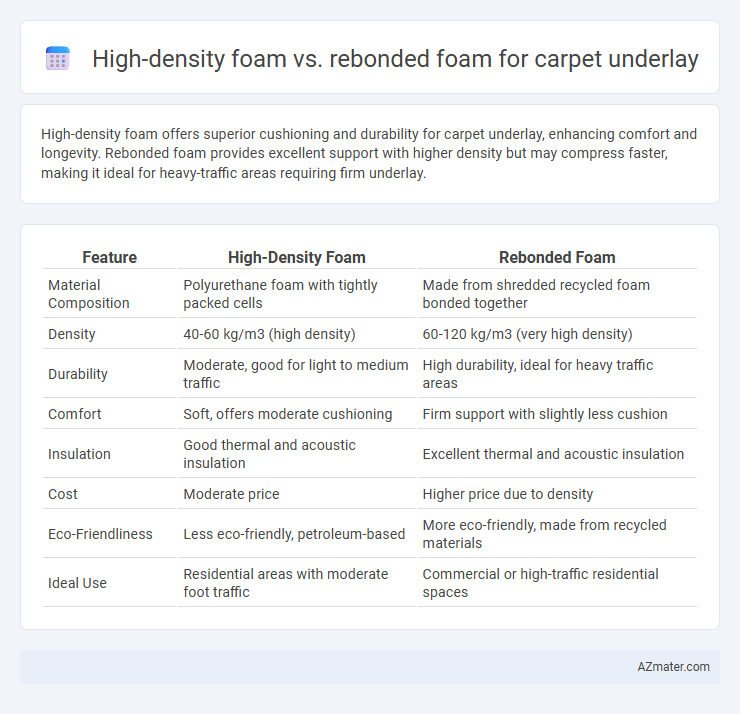High-density foam offers superior cushioning and durability for carpet underlay, enhancing comfort and longevity. Rebonded foam provides excellent support with higher density but may compress faster, making it ideal for heavy-traffic areas requiring firm underlay.
Table of Comparison
| Feature | High-Density Foam | Rebonded Foam |
|---|---|---|
| Material Composition | Polyurethane foam with tightly packed cells | Made from shredded recycled foam bonded together |
| Density | 40-60 kg/m3 (high density) | 60-120 kg/m3 (very high density) |
| Durability | Moderate, good for light to medium traffic | High durability, ideal for heavy traffic areas |
| Comfort | Soft, offers moderate cushioning | Firm support with slightly less cushion |
| Insulation | Good thermal and acoustic insulation | Excellent thermal and acoustic insulation |
| Cost | Moderate price | Higher price due to density |
| Eco-Friendliness | Less eco-friendly, petroleum-based | More eco-friendly, made from recycled materials |
| Ideal Use | Residential areas with moderate foot traffic | Commercial or high-traffic residential spaces |
Understanding Carpet Underlay: Purpose and Importance
High-density foam offers superior cushioning and durability for carpet underlay, effectively absorbing impact and enhancing comfort underfoot. Rebonded foam, made from recycled foam scraps, provides excellent support and long-lasting resilience, making it an eco-friendly and cost-effective option. Both types improve carpet lifespan by reducing wear and providing thermal insulation, highlighting their essential role in carpet performance and comfort.
What is High-Density Foam Underlay?
High-density foam underlay is a premium carpet underlay made from polyurethane foam with a higher density, typically above 30 kg/m3, providing superior support and durability. It offers excellent cushioning, enhancing comfort underfoot, and improved thermal and acoustic insulation for residential or commercial flooring. High-density foam underlay resists compression over time, ensuring long-lasting performance and maintaining the carpet's appearance.
What is Rebonded Foam Underlay?
Rebonded foam underlay is made from shredded scrap foam that is bonded together using adhesive and compressed into dense sheets, offering excellent durability and support beneath carpets. This type of underlay provides superior resilience and impact absorption compared to traditional high-density foam, enhancing comfort and extending carpet lifespan in high-traffic areas. Its recycled composition makes rebonded foam an eco-friendly choice that balances performance with environmental sustainability.
Comfort and Cushioning: Comparing the Feels
High-density foam provides a softer, more luxurious feel with superior cushioning that molds to the foot's contours, enhancing comfort under carpet. Rebonded foam, made from recycled foam scraps, offers firmer support and greater durability but may feel less plush and resilient over time. Choosing between them depends on the desired balance of softness versus long-lasting structural support beneath the carpet.
Durability and Lifespan: Which Lasts Longer?
High-density foam carpet underlay offers excellent durability due to its consistent cell structure, providing long-lasting support and maintaining its shape over time. Rebonded foam, made from shredded foam scraps bonded together, tends to be less durable as it compresses more quickly under heavy traffic, leading to a shorter lifespan. For homeowners seeking extended durability and a longer-lasting carpet foundation, high-density foam is typically the superior option.
Noise Reduction Performance
High-density foam offers superior noise reduction performance in carpet underlays due to its dense cellular structure that effectively absorbs and dampens sound vibrations. Rebonded foam, composed of bonded foam scraps, provides moderate sound insulation but tends to be less consistent in noise reduction compared to high-density foam. For optimal acoustic insulation in residential or commercial spaces, high-density foam underlays significantly outperform rebonded foam by minimizing impact noise and airborne sound transmission.
Moisture Resistance and Mold Prevention
High-density foam offers superior moisture resistance compared to rebonded foam, reducing the risk of mold growth in carpet underlays by effectively limiting water absorption. Rebonded foam, composed of recycled foam scraps bonded with adhesives, tends to retain more moisture, creating an environment conducive to mold development. Selecting high-density foam for carpet underlay improves indoor air quality and extends flooring lifespan by preventing dampness-related damage.
Installation and Maintenance Considerations
High-density foam carpet underlay provides a smoother installation process due to its uniform structure, reducing the risk of lumps and ensuring consistent support, while rebonded foam may require more careful cutting and fitting because of its composite nature. Maintenance of high-density foam is typically easier, as it resists compression and retains its cushioning properties longer, whereas rebonded foam can degrade faster under heavy foot traffic, necessitating more frequent replacement. Both types benefit from proper moisture barriers during installation to extend lifespan and maintain hygiene.
Cost Comparison: High-Density vs Rebonded Foam
High-density foam typically costs more upfront due to its superior durability and resilience compared to rebonded foam, which is made from recycled foam scraps and offers a budget-friendly option. Rebonded foam underlay provides good support at a lower price but may compress faster, potentially requiring earlier replacement and increasing long-term expenses. Investing in high-density foam can result in better carpet longevity and comfort, making it cost-effective over time despite the higher initial outlay.
Which Underlay is Best for Your Carpet?
High-density foam underlay offers excellent cushioning, durability, and sound insulation, making it ideal for residential areas with moderate foot traffic. Rebonded foam underlay, made from recycled foam scraps, provides superior support and resilience, perfect for high-traffic commercial spaces requiring long-lasting performance. Choosing the best carpet underlay depends on your specific needs: high-density foam suits comfort-focused home environments, while rebonded foam excels in durability and support for busy areas.

Infographic: High-density foam vs Rebonded foam for Carpet underlay
 azmater.com
azmater.com